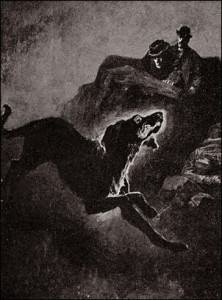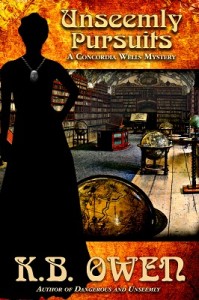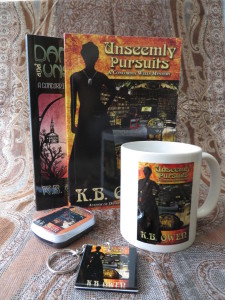by Kathy Owen, @kbowenwriter
Elizabeth invited me to share with you one of my favorite classic detective novels, Sir Arthur Conan Doyle’s The Hound of the Baskervilles. I love talking about the classics with fellow mystery lovers!
The Hound of the Baskervilles (1901-02) has been regarded by current and contemporary Sherlockians as the best of the four novels. Since its publication, it has been adapted dozens of times for radio, film, and television.

Hound beginnings:
The year 1901 marked the death of Queen Victoria and saw Doyle well-established in his career: he had achieved many of his personal goals, and was considered a serious writer and popular public speaker. That year, Doyle went on a golfing holiday in Norfolk with his friend Fletcher Robinson. On a dreary, rainy day, when golfing was out of the question, Robinson passed the time by recounting to Doyle the West Country legend of a spectral hound, which gave Doyle the idea for his story. Blogger and writer Gene Lempp wrote a fascinating post on the Legend of Black Shuck which gives more detail.
Doyle subsequently traveled to the Dartmoor area to get local color for the story, which was originally not intended to feature Holmes (he had already killed off Holmes in “The Final Problem” – pitching him over the Reichenbach Falls with Professor Moriarty). According to Doyle, Holmes sort of worked his way into the story; so, rather than resurrect Holmes (although he did later, in 1903), Doyle made the story a reminiscence by Watson of an earlier undocumented case.
The Hound of the Baskervilles was serialized in The Strand Magazine (where most of the stories were serialized) over a nine-month period, from August 1901 to April 1902. It was eagerly received, and long lines formed at the publisher’s office when the next installment was due out.

There’s a lot to admire about the novel, but I’ll keep to a few interesting aspects.
Narrative strategies in Hound:
Doyle was master of the cliff-hanger. He knew how to break up the segments to keep the readers hooked. The first magazine installment, for example, ends with Watson’s sleep being disturbed by: “the sob of a woman, the muffled, strangling gasp of one who is torn by uncontrollable sorrow.” Other cliff-hangers involve a dead body, a stealthy stranger, and mysterious noises in the night.

In Hound, Doyle was able to resolve the narrative difficulty he’d had in two earlier full-length Holmes novels: how to explain the complex and lengthy series of events that lead up to a crime without the use of long flashbacks or tedious explanations that interrupt the story. Instead, Doyle used different narrative voices: those of the client, a 17th century manuscript, Watson, and Holmes, who later relays his own account of the time when he and Watson are working the case separately.
The separation of the Holmes/Watson team is unusual as well. Without Holmes on the scene to guide him, Watson has his chance in the limelight as a detective. It is a role that weighs heavily on him, however. The reader shares the feeling of vulnerability in Holmes’s absence.
Gothic elements:

The novel’s Gothic horror story trappings make it an unusual setting for a detective story: a family curse, a dark, primitive moor, a seemingly-supernatural hound, a black-hearted villain. There are lots of “thrills and chills.” But it’s a detective story through and through, because the Gothic is not its solution. There is a rational explanation for everything. Some scholars posit this is why Doyle instinctively felt that Holmes belonged in the story.
Psychoanalytic facets of the novel:
During the time that Doyle was writing the Holmes stories, Freud was developing his theories of the unconscious mind and repression. Writers such as Conrad, Stevenson and James wrote symbolic stories in which the source of evil existed within the mad soul and had to be restrained by the intellect. The Hound of the Baskervilles treats the problem of human evil from a psychological perspective rather than a metaphysical/ supernatural one. Scholars like to read the wild, lonely, treacherous moors as symbolic of the repressed unknown unconscious mind, uncivilized and barbaric. Using this interpretation, the moor would act in conjunction with characters in the story (including the neolithic savages, the original inhabitants of the moor) to depict the unconscious, dark side of the human soul, or the primitive part of man existing beneath the civilized veneer, if you will.
There’s more I could say about this (we haven’t even touched Jungian theory), but we want stuff to discuss in the comments section! I hope you’ll give The Hound of the Baskervilles a second (or first) look.
Bio:

K.B. Owen taught college English at universities in Connecticut and Washington, DC and holds a doctorate in 19th century British literature. A long-time mystery lover, she drew upon her teaching experiences in creating the Professor Concordia Wells mystery series. The first book, Dangerous and Unseemly, was published in early 2013.
The second book, Unseemly Pursuits: A Concordia Wells Mystery, has just been released:

A deadly secret that won’t stay buried…
It is the fall of 1896, and Miss Concordia Wells is hip-deep in the usual tumult of a lady professor’s life: classes, clubs, student pranks, and the unending drama generated by the girls she lives with on campus. Complicating this normality is the new Lady Principal, whom the students have nicknamed “the Ogre.” The woman seems bent on making Concordia’s life miserable.
And then there’s the exotic spirit medium, Madame Durand, who has befriended Concordia’s mother and has started a “Spirit Club” on campus. Madame’s prognostications of doom are at first only mildly irritating – until events take a sobering turn. An ancient Egyptian amulet donated to the college mysteriously disappears, the donor is found murdered, and his daughter – Concordia’s best friend – confesses to killing him.
Desperate for answers, Concordia unravels a 20-year-old secret, closely guarded by men now dead. But such secrets can be dangerous for the daughters left behind, including Concordia herself. Can she make sense of the mystery that has bound together their fates, before it’s too late?
Unseemly Pursuits is available through these venues:
Kathy’s also hosting a giveaway! A randomly-selected winner from the comments section of each guest post on her blog tour (comments up through March 6, 2014) will receive a free e-copy of Unseemly Pursuits. One grand-prize winner from all of the ebook winners will receive an Unseemly Pursuits swag kit! This includes a mug, JellyBelly tin, keychain, and two signed paperbacks: her first novel in the series, Dangerous and Unseemly, along with Unseemly Pursuits. (If the grand-prize winner lives outside the U.S., she or he will receive a $50 Amazon gift card instead, because of the cost of shipping).

Ironically, I bet Doyle never went to the depths to plan the metaphors and certainly not to the extent at which people have analyzed his work.
I wonder if The Hound of the Baskervilles was the original inspiration for Scooby-Doo?
Well put, KB. We could learn a lot from Doyle.
Alex, most symbols/motifs/settings in stories aren’t actually “planned” by the author with an eye to their later analysis by scholars, but it’s neat when it works out that way, LOL.
And I LOVE Scooby-Doo! ;)
This was very interesting – love seeing classics analyzed this way, and the images were very enlightening.
Never thought about Watson’s time in the limelight and I always thought it was a Gothic novel, but of course you’re right, it’s not the creepiness that solves things, it’s reason.
The authors novels sound so good! LOVE how the protag is a lady professor and how it takes a historical look at college life along with the mystery:)
Thank you! :)
Christina, thank you! I hope you get a chance to check it out. :)
I love analyzing Hound: maybe it’s the former professor trying to get loose, but it’s such a rich story.
Elizabeth – Thanks for hosting Kathy.
Kathy – Thanks for your insights on Hound of the Baskervilles. Such an enduring novel. I think one of the things that strikes me most about it is the atmosphere. The scene that really stays with me is the scene when Watson first arrives at the house. Conan Doyle did a really effective job of evoking the place, complete with eeriness.
Doyle certainly was the master of atmosphere, wasn’t he, Margot? It’s so cool when a book stays with you like that, too.
I’ve never been good at cliff-hangers.
LOL L. Diane, Doyle got lots of practice writing all those serial installments. ;)
Kathy – I haven’t read The Hound of the Baskervilles for a long time. I taught it to my grade 9 English class 25 years ago, and have certainly read it since. Now I want to read it again! Thanks for sharing your insights. I’ll be looking for your books, too.
Heather – my boys would wish they had you as 9th graders! What a great story for that group. I taught it to freshman/sophomore college lit classes way back, and they really enjoyed it (and we had to watch some film scenes, right?).
Happy to hear you’ll be looking for my series – thanks!
The Hound of the Baskervilles remains one of my favorite of the Sherlock Holmes’ books! I remember reading it and thinking how brilliant the first description of the antagonist was. Doyle’s introduction of Mr. Jack Stapleton is as far from a dark villain as you can get. A straw hat and a butterfly net? Genius.
Kendra, I hadn’t thought of that, but you’re absolutely right! I agree – brilliant. ;)
How fun to know the story behind the story! Thanks
You bet, Juliel! Happy to share. :)
Elizabeth, thanks again for hosting me – it’s always so much fun!
Kathy, thanks so much for posting today! As others have said, this is one of my most favorite stories. The tone/mood, the story, the amazing characters…and I love the way you’ve analyzed it. Found Doyle’s narrative strategies here fascinating–thanks for sharing this!
The early serial writers really new how to pace and keep you wanting more. Wilkie Collins is another fav of mine in that sense, but Holmes… There’s only one Sherlock Holmes.
So true, Kirsten. They sure had lots of practice!
Fine post, Kathy. I’ve always been a big fan of Doyle and consider HOUND his finest work. Although of course derivative, Laurie King did it a fine homage with “The Moor”.
Thanks Dario, and I love the Mary Russell books, too!
A most enjoyable post! Is there anything eerier than the Grimpen Mire? The Hound is, without a doubt, a timeless classic, and I enjoy all things Holmes, Watson, and their creator. Thank you for your insight.
Cortland, thanks! There’s something about that quicksand that just makes one shudder. Oohh…
Excellent investigation, Kathy :). I just reread Hound a few years ago — actually listened to it on MP3. It completely holds up and is still my favorite Holmes story. Holmes presence is actually stronger for his absence.
That would be an awesome story on audio! Thanks for stopping by, Debra. :)
When I was 13-14 yo, I was sitting on my bed reading that book (great book, btw). Then, at some point, I heard for the first time in my life, Led Zeppelin’s Stairway to Heaven on the radio. It immediately became a fovorite song of mine (and still is). Everytime I hear the song, I can’t help thinking of The Hound of the Baskerville >:)
Isn’t it funny how that works, CA? I think it’s the perfect age to be exposed to both. ;)